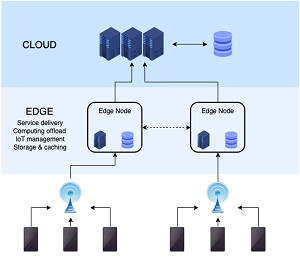News
Cloud Platforms Increasingly Taking It to the Edge
Cloud computing vendors Amazon Web Services (AWS), Microsoft Azure and Google Cloud Platform (GCP) are increasingly taking their services to the edge in the era of IoT.
While seemingly a new buzzword, "edge" (as in computing) has been a thing for years.
"The edge is exactly what it sounds like: a solution in which compute and storage are offered hyperlocally," said VCRM writer Trevor Pott in a 2017 article. "This is being driven by the proliferation of Internet of Things (IoT) devices. Many proposed use cases for IoT devices rely on the ability to make quick decisions based on sensor data, decisions that may take too long if the data has to be trucked back to a centralized data farm and then back again."
Or, for a more formal definition, Wikipedia says: "Edge computing is a distributed computing paradigm which brings computation and data storage closer to the location where it is needed, to improve response times and save bandwidth. Modern edge computing significantly extends this approach through virtualization technology that make it easier to deploy and run a wider range of applications on the edge servers."
 [Click on image for larger view.] Edge Computing (source: Wikipedia).
[Click on image for larger view.] Edge Computing (source: Wikipedia).
Research firm Gartner reports on the WAN infrastructure market, most recently ranking providers such as Aryaka, Cisco, CloudGenix, Fortinet and Huawei.
However, the aforementioned cloud giants have also been busy taking their edge services directly to customers. Following is a look at what's new in this space.
Google Cloud last month unveiled a new Global Mobile Edge Cloud (GMEC) strategy tied to the burgeoning 5G initiative, a game-changer for wireless connectivity. That strategy involves a pact with AT&T, which has been on the forefront of the 5G transformation, tying it to yet another transformative technology, software-defined wide-area-networks (SD-WAN).
As part of GMEC, Google Cloud and AT&T will collaborate to help enterprises leverage Google Cloud’s technologies and capabilities using AT&T network connectivity at the edge, including 5G.
Google Cloud also announced Anthos for Telecom, bringing its Anthos cloud platform to the network edge to enable telecommunications companies to run their applications wherever it makes the most sense.
"Finally, Google Cloud can partner with telecommunications companies to rapidly enable a global distributed edge by lighting up thousands of edge locations that are already deployed in these telecom networks," Google said.
Just a few weeks later, Microsoft followed suit, announcing its own industry pact "to unlock new 5G scenarios with Azure Edge Zones."
Those scenarios enabled by preview technology include:
- Development of distributed applications across cloud, on-premises and edge using the same Azure Portal, APIs and security tools.
- Local data processing for latency critical industrial IoT and media services workloads.
- Acceleration of IoT, AI, and real-time analytics by optimizing, building, and innovating for robotics, mixed reality, and automation tools.
- New frontiers for developers working with high-density graphics and real-time operations in industries such as gaming.
"Cloud, edge computing, and IoT are making strides to transform whole industries and create opportunities that weren't possible just a few years ago," Microsoft said in a March 31 announcement. "With the rise of 5G mobile connectivity, there are even more possibilities to deliver immersive, real-time experiences that have demanding, ultra-low latency, and connectivity requirements. 5G opens new frontiers with enhanced mobile broadband up to 10x faster, reliable low-latency communication, and very high device density up to 1 million devices per square kilometer."
Cloud kingpin AWS, meanwhile, has a plethora of services documented on its AWS IoT for the Edge site, including:
- AWS IoT Greengrass, extending AWS to edge devices so they can act locally on the data they generate, while still using the cloud for management, analytics, and durable storage.
- FreeRTOS, an open-source, real-time OS for microcontrollers that makes small, low-power edge devices easy to program, deploy, secure, connect, and manage.
- AWS IoT Device Tester, a test automation tool for IoT devices used to easily determine if your device will run FreeRTOS or AWS IoT Greengrass and interoperate with AWS IoT services.
In addition, last month AWS announced other new capabilities for its edgy serverless computing offering, Lambda@Edge, part of the CloudFront family, aimed at helping developers run code closer to users of applications in order to improve performance and reduce latency.
Also, AWS has been targeting the edge with other services, just last week announcing optimization enhancements to its Snowball storage appliance. "Edge compute capabilities in the new device increased to 40 vCPUs and 80 GiB of memory, supporting sbe-c instance types for running applications at the edge," AWS said.
Other edge-related improvements to the Snowball offering included:
- AWS OpsHub for Snow Family – A new GUI-based tool to simplify the management of Snowball Edge devices.
- IAM for Snowball Edge – AWS Identity and Access Management (IAM) can now be used to manage access to services and resources on Snowball Edge devices.
- Snowball Edge Support for AWS Systems Manager – Support for task automation to simplify common maintenance and deployment tasks on instances and other resources on Snowball Edge devices.
Look for many more edge-related offerings and enhancements from the cloud giants as they seek to address the growing space. As Forbes recently reported in article titled "Predictions 2020: Edge Computing Makes The Leap":
The edge cloud service market will grow by at least 50%. Public megacloud providers, telecommunication companies, platform software providers, content delivery networks, and data center colocation providers are innovating to provide basic infrastructure-as-a-service (IaaS) and advanced cloud-native programming services on distributed edge computing infrastructure. The goal of these vendors is to offer IaaS and platform-as-a-service (PaaS) services that run independently of or with only intermittent connectivity to public cloud and data center assets. In 2020, this nascent market will begin to see explosive growth.
About the Author
David Ramel is an editor and writer at Converge 360.